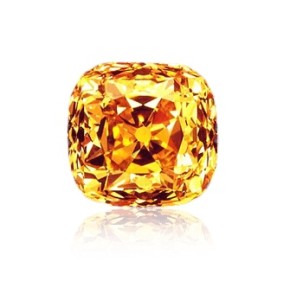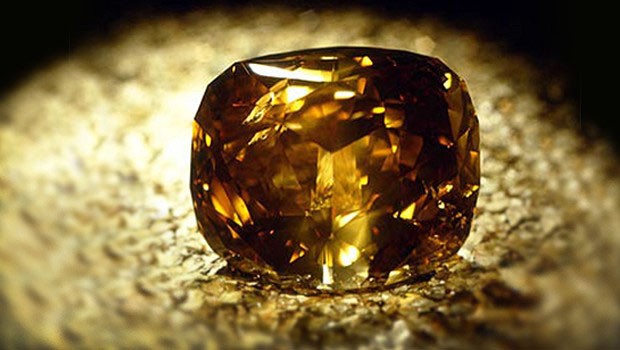It can be difficult to judge an object's beauty at first glimpse. This is particularly true in the case of colored diamonds. The Golden Jubilee Diamond is a perfect example of this.
While certain stones may not appear spectacular when originally discovered, they can be transformed into gorgeous diamonds during the cutting process.
The Golden Jubilee is currently, the undisputed largest faceted diamond in the world,
It is approximately 545.67 carats and took several years to cut and polish before being presented to the King of Thailand, its current owner in 1997.
At 109.13 grams, the huge Golden Jubilee Diamond is truly magnificent. Although it may appear a somewhat orange color in various photos, it has in fact been graded as a fancy yellow-brown diamond. It has a distinctive fire rose cushion cut and weighs 545.67 carats, 15.37 carats more than the second-largest diamond, the Cullinan 1.
It can be difficult to judge an object's beauty at first glimpse.
This is particularly true in the case of colored diamonds. While certain stones may not appear spectacular when originally discovered, they can be transformed into gorgeous diamonds during the cutting process. The Golden Jubilee Diamond, which measures 545.67 carats and is the world's largest polished brown diamond, is a wonderful illustration of this. While there is no doubting that this diamond is stunning today, it was not always so.
Here's how one of the modern world's most renowned diamonds came to be.
From a Royal Past to a Glorious Future
The Golden Jubilee was discovered in Transvaal, South Africa, in 1985, at the De Beers Premier Diamond Mine, which also produced the Cullinan, Taylor Burton, and Niarchos diamonds. The stone weighed 755 carats in its raw state!
The massive diamond, which was graded fancy yellow-brown - the conventional definition of a champagne diamond - was deemed undesirable due to deep fissures and tiny imperfections.
New cutting methods had recently been invented, and the diamond's extraordinarily enormous size provided an ideal opportunity to put them to the test. De Beers saw immense promise in the brown diamond and set out to polish it with this newer technology in order to improve its beauty.
Gabriel Tolkowsky, who previously worked on the flawless white Centenary Diamond, was hired by the business to cut the diamond, which was nameless at the time. The cutting procedure took two years, but it was unquestionably worth the wait.
At the time, the master diamond cutter was quoted as saying "Within its center was a beautifully fascinating sparkle that gave the diamond a character unlike any other."
The newly polished gem was eclipsed by the De Beers Centennial Celebration in 1988, which received far more coverage and attention. Despite this, the rose cushion-cut stone was sent to Laem Chang, Thailand, for a major Thai Board of Investment Exhibition.
In 1995, De Beers sold the diamond to Henry Ho, a Thai businessman. It was then blessed by Pope John Paul II, who was then the Supreme Buddhist Patriarch and eventually the High Imam of Thailand.
The Thai Diamond Manufacturers Association then offered the diamond to King Rama IX, popularly known as Bhumibol Adulyadej, as a gift to commemorate his coronation 50 years ago in 1997. This year was designated as The Golden Jubilee.
Interesting fact: According to 24hgold, the Thai government labeled the stone as a huge golden topaz because the country was in financial trouble and didn't want residents to be offended by the purchase.

The Fate of the Golden Jubilee Diamond
The Golden Jubilee was supposed to be enshrined in the royal scepter or one of the royal seals at first, but that did not happen It is currently on exhibit at the Pimammek Golden Temple Throne Hall in Bangkok's Royal Museum and that does seem to be its fate for the foreseeable future.
The Golden Jubilee is worth between $4 and $12 million, according to Luxatic. However, given the recent spike in the price of colored diamonds, it could be worth even more were it ever evaluated again.
One of the diamond's most awe-inspiring and defining characteristics is its sheer weight. Henry Ho compared its size to two chicken eggs in an interview with the Natural Color Diamond Association.
The Golden Jubilee, as MonoPetro pointed out, broke all previous records. It is, in fact, 15.37 carats greater than the well-known Cullinan I.
Other Notable Large Colored Diamonds
The Golden Jubilee is the largest of the world's cut diamonds at this point, but there are other colored diamonds that come very close. Here's a look at some of those:
Moussaieff Red
The Moussaieff Red, which is the largest known natural color red diamond at 5.11 carats, is famous for its color and size. It was said to have been discovered in its rough condition, weighing 13.90 carats, by a Brazilian farmer in the 1990s.
The stone was purchased and cut into its triangle shape (also referred to as a trillion or trilliant) by the William Goldberg Diamond Corporation, and the GIA grade determined that it was the largest red diamond ever graded. It was eventually purchased by Moussaieff Jewellers Ltd. for an unknown sum in 2001. Although it was definitely expensive, this red diamond is internally flawless, which has likely increased its value.
The Koh-i-Noor
The Koh-i Noor Diamond (Persian for "Mountain of Light") once held the record for being the world's largest diamond, and its current weight is 108.93 carats. It has the longest history of any known diamond, beginning in India. Its history is littered with battles for control between Mughal and Indian royal owners.
The Koh-i Noor was seized by the East India Company as part of a partial indemnity following a fight with the Sikhs, and it was delivered to Queen Victoria when she was declared Empress of India in 1877, and it has been part of the British Crown Jewels stored in the Tower of London ever since. The mythology associated with this diamond grants its owner sovereignty over the entire globe.
The Darya-i Noor
This pink diamond, which has a very uncommon pink hue shade not commonly seen in nature, is estimated to weigh 182 carats, making it one of the world's largest pink diamonds.
It has a wide and oblong shape and measures 41.40 mm x 29.50 mm x 12.15 mm. Darya-I Noor, which means "Sea of Light," has a roughly 400-year history. It was discovered in the Golconda Mines in India. In 1739, Nader Shah, a Persian prince who invaded that region of India, took the Mughal treasury, including the pink Darya-i-Noor diamond, in exchange for returning the Mughal crown, and returned his loot to Persia, where the Darya-i Noor was passed down through many dynasties.
It was eventually stored in the Treasury Museum and only worn on special occasions. According to scholars, the Darya-i-Noor pink diamond was part of Tavernier's "Diamanta Grande Table," a 400-carat diamond that adorned the Mughal monarch Shah Jahan's throne and was cut into two pieces, one of which became the Darya-i Noor Pink. This pink diamond is now part of Iran's Crown Jewels and is on permanent exhibit in Tehran.







